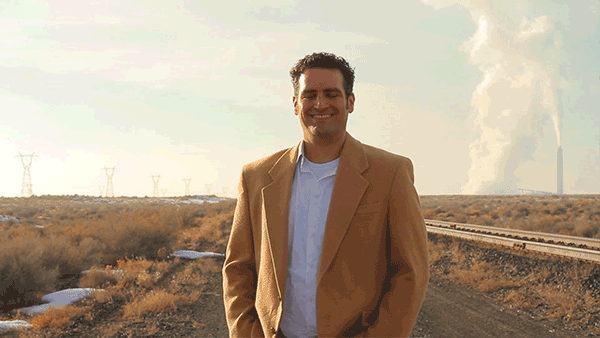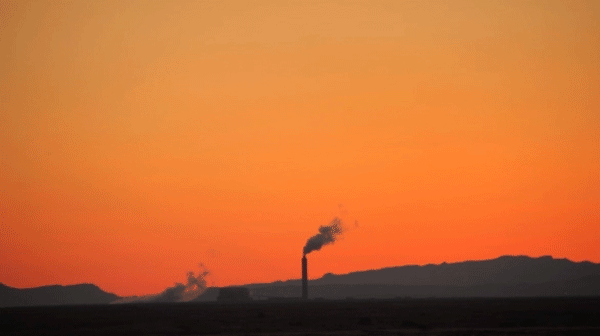Friday, February 21, 2014
Tech / Travel Found the damndest thing in Delta: ECG Utah Solar 1
Posted By Desiree Kane on Fri, Feb 21, 2014 at 10:03 AM

I've been a field producer on local independent journalist/CL contributor Rhiannon Fionn's investigative documentary project called Coal Ash Chronicles for the past two or so years. Back in November, the project took video journalist Kevin J. Beaty and I out to Delta, Utah, to do a profile piece on nearby Millard County's Intermountain Power Project's coal ash beneficial re-use practices. While we were out in the desert, we found the damndest thing: ECG Utah Solar 1. It's a 300MW solar power facility in the works that is tapping into a coal power plant's infrastructure to bring renewable energy to six municipalities in Southern California, L.A. being the largest.
Considering North Carolina's coal ash woes, thanks to the massive Duke Energy spill into the Dan River a couple of weeks ago, West Virginia's before and after that, ECG Utah Solar 1 offers a model for communities beginning to actively look past coal power. We decided to take a second trip back to Millard County just to cover the creation of what will one day be one of the nation's largest solar power plants. Here's what we found.:

Delta, only a few miles from both IPP and ECG Utah Solar 1 future build site, is a tiny little town of less than 4,000 people and only a couple of stoplights.

Grant Nielson was the town mayor when IPP was being constructed in 1981. We found him at The Rancher Cafe. "There are approximately 500 jobs out there at the power plant. Delta would be a sad agriculture community without those jobs. It brought in a lot of the learned people. It kind of mixed up our blood and we needed that."
John Ward, spokesperson for Intermountain Power Agency, a power co-op of 29 municipalities in Utah and California respectively, took us on a tour of IPP back in November and showed us how coal ash is transported from the power plant on its way to become concrete. The EPA has recently declared coal ash as safe for use in certain building materials, so he was keen to show off the plant. Since he's so plugged into that world, he was a great person to follow up with about the land surrounding IPP and how it's being used.

"I don't think the founders of the Intermountain Power Project in the 1970s had any idea what could happen at the site later on. Their original plan was to build four very large coal-fueled units - only two of them actually got built, which is another reason why this site is so attractive as a development hub. If you would have said in 1978 that we would have a solar farm near the plant, that was kind of science fiction back then. Now, however, it makes a lot of sense. It was planned for twice as much energy coming out of there."
LADWP is the balancing authority that is in charge of the power sub station. Curiously, this is California land in Utah and one of the primary reasons companies are choosing to develop here.

Enter Josh Case, CEO of ECG Utah Solar 1, who agreed to an interview about the current state and future of the project. The 300MW ECG Utah Solar 1 facility will provide power to roughly 80,100 to 100,000 homes, all from this tiny dot on the map out in Utah.:

I got a chance to ask him about his background, which has surprising ties to Charlotte's very own Bank of America.:
I also asked about the subsequent benefits of the project, beyond the 250-plus jobs the plant will provide during the height of its construction:
It is, however, undisclosed how much in financial support that will amount to yet since the project is still in the planning stages. I asked how the land would be impacted and if there are any environmental or cultural risks to building here specifically.:

"California is the driving force when it comes to energy being generated in Millard County," says Linda Gillmore, Millard County's Economic Development Director. "They would have to put that energy generation on their own property and what's interesting is that they seem to have even a harder time permitting, even for renewables, in their own state and so that puts them in a position where they have to depend on other states. So I would say yes, we are interdependent."

"Who would have ever imagined that a rural farming area would wind up being an energy hub?"
Millard County and ECG both announced that the vital conditional use permit was issued on Tuesday to Energy Capital Group. The next step for the project is to secure a power purchase agreement with one or more of the six Southern California municipalities mentioned above. I'll continue loose coverage of this until it opens in 2015.

For more commentary, follow me on Twitter @dbirdy, for more photos peep my Flickr, if you're into the travel philosophy thing read my website, and to see a bunch of random and fun travel videos, subscribe to my YouTube channel!
Zero, zilch, none and no part of this post is sponsored by any of the above mentioned company or companies, nor would I ever present such a thing. Those cool moving portraits credit: Kevin J. Beaty
Speaking of...
-

The World’s 7 Most Beautiful Casino Resorts
Sep 15, 2020 -

Top Affordable Winter Destinations for Your Average Joe
Jan 23, 2020 -

The 5 Best Places for Students to Study Abroad in 2020
Jan 16, 2020 - More »
Latest in Wayfaring Tech Nomad
More by Desiree Kane
-

BlendConf: Just what Charlotte's tech environment needs
Aug 21, 2014 -

Misappropriating Native American culture is not entertainment
May 22, 2014 -

Best North Carolina memes for 2014 (so far)
May 16, 2014 - More »





